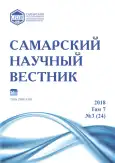Морфобиологическая и биохимическая характеристика растений Tanacetum vulgare L. в условиях культуры
- Авторы: Портнягина Н.В.1, Эчишвили Э.Э.1, Пунегов В.В.1, Фомина М.Г.1
-
Учреждения:
- Институт биологии Коми научного центра УрО РАН
- Выпуск: Том 7, № 3 (2018)
- Страницы: 88-93
- Раздел: 03.02.00 – общая биология
- URL: https://journals.rcsi.science/2309-4370/article/view/21693
- DOI: https://doi.org/10.17816/snv201873116
- ID: 21693
Цитировать
Полный текст
Аннотация
Представлены результаты интродукционного изучения семи образцов Tanacetum vulgare разного географического происхождения в условиях культуры. Выявлено, что в первый год жизни растения пижмы обыкновенной вегетируют, со второго года регулярно цветут и плодоносят. Установлено, что в условиях культуры вид отличается высокой устойчивостью и долголетием (более 12 лет). Исследование сезонного ритма роста и развития растений Tanacetum vulgare показало, что период цветения составляет 33–44 дня, период плодоношения – 44–52 дня, а весь период от начала вегетации до формирования зрелых плодов варьирует по годам от 116 до 138 дней; максимальные показатели высоты побегов (109–131 см) отмечены в фазу цветения, среднесуточного прироста (до 2,6–3,6) – в период бутонизации. По срокам вступления растений в фазу цветения выявлены ранние и поздние образцы. Изучены морфологические параметры генеративного побега. Выявлено, что признаки, характеризующие флоральную часть побега, варьируют в популяциях на высоком и очень высоком уровнях, что свидетельствует о реальной возможности улучшения популяции методом целенаправленного отбора. Определена продуктивность и компонентный состав эфирного масла из надземной фитомассы Tanacetum vulgare. Полученные результаты позволяют говорить о возможности выращивания данного вида с целью получения качественного лекарственного сырья. Выявлен оптимальный способ культивирования для создания долговременных плантаций.
Ключевые слова
Полный текст
Открыть статью на сайте журналаОб авторах
Надежда Васильевна Портнягина
Институт биологии Коми научного центра УрО РАН
Email: portniagina@ib.komisc.ru
кандидат сельскохозяйственных наук, доцент, старший научный сотрудник отдела Ботанический сад
Россия, СыктывкарЭльмира Элизбаровна Эчишвили
Институт биологии Коми научного центра УрО РАН
Email: elmira@ib.komisc.ru
кандидат биологических наук, научный сотрудник отдела Ботанический сад
Россия, СыктывкарВасилий Витальевич Пунегов
Институт биологии Коми научного центра УрО РАН
Email: punegov@ib.komisc.ru
кандидат химических наук, старший научный сотрудник отдела Ботанический сад
Россия, СыктывкарМарина Геннадьевна Фомина
Институт биологии Коми научного центра УрО РАН
Автор, ответственный за переписку.
Email: fomina@ib.komisc.ru
старший лаборант-исследователь отдела Ботанический сад
Россия, СыктывкарСписок литературы
- Атлас ареалов и ресурсов лекарственных растений СССР. М.: ГУГК, 1983. 340 с.
- Флора Северо-Востока европейской части СССР. Л.: Наука, 1977. Т. 4. С. 180-181.
- Махлаюк В.П. Лекарственные растения в народной медицине. Саратов: Приволжское книжное изд-во, 1991. 544 с.
- Растения для нас. Справочное издание / К.Ф. Блинова, В.В. Вандышев, М.Н. Комарова и др. СПб.: Учебная книга, 1996. 654 с.
- Пастушенков Л.В., Пастушенков А.Л., Пастушенков В.Л. Лекарственные растения: Использование в народной медицине и быту. Л.: Лениздат, 1990. 384 с.
- Современная фитотерапия / под ред. В. Пяткова. Перевод с болгарского Т.В. Матвеевой. София: Медицина и физкультура, 1988. С. 329.
- Колесова В.Г., Марченко В.А., Сыровежко Н.В. Лекарственные растения: мифы и реальность. Традиционная (народная) медицина в объективе науки. СПб.: СПХФА, 1998. 261 с.
- Семенихин Д.И. Биологические особенности роста и развития валерианы лекарственной, зверобоя продырявленного и пижмы обыкновенной в совместных посевах с однолетними культурами: автореф. дис. … канд. биол. наук. М., 2007. 23 с.
- Васфилова Е.С., Воробьева Т.А. Лекарственные и пряноароматические растения в условиях интродукции на Среднем Урале. Екатеринбург: УрО РАН, 2011. 245 с.
- Мильшина Л.А., Первышина Г.Г., Ефремов А.А., Кириенко Н.Н. Сезонная изменчивость состава эфирного масла в вегетативной части пижмы обыкновенной // Вестник КрасГАУ, 2012. № 7. С. 75-78.
- Кочукова А.А. Биологическая характеристика пижмы обыкновенной (Tanacetum vulgare L.) на территории Оренбургского Предуралья: автореф. дис. … канд. биол. наук. Оренбург, 2014. 18 с.
- Мишуров В.П., Интродукция полезных растений в подзоне средней тайги Республики Коми (Итоги работы Ботанического сада за 50 лет; Т. 1) / В.П. Мишуров, Г.А. Волкова, Н.В. Портнягина. СПб., 1999. 216 с.
- Портнягина Н.В., Пунегов В.В., Эчишвили Э.Э., Фомина М.Г. Итоги интродукции лекарственных растений // Вестник Института биологии Коми НЦ УрО РАН. 2011. № 6 (164). С. 23-36.
- Майсурадзе Н.И., Киселев В.П., Черкасов О.А., Нухимовский Е.Л., Тихонова В.Л., Макарова Н.В., Угнивенко В.В. Методика исследований при интродукции лекарственных растений // Лекарственное растениеводство. М., 1984. Вып. 3. 33 с.
- Методика фенологических наблюдений в ботанических садах СССР // Бюл. Главн. ботан. сада. 1979. Вып. 113. С. 3-8.
- Мамаев С.А. Основные принципы методики исследования внутривидовой изменчивости древесных растений // Индивидуальная и эколого-географическая изменчивость растений: сб. статей. Свердловск, 1975. С. 3-14.
- Зайцев Г.Н. Методика биометрических расчетов. М.: Наука, 1973. 256 с.
- Николаева М.Г., Лянгузова И.В., Гладкова В.Н. Справочник по проращиванию покоящихся семян. Л.: Наука, 1985. 347 с.
- Кузнецова Т.В., Пряхина Н.И., Яковлев Г.П. Соцветия. Морфологическая классификация. СПб.: Химико-фарм. ин-т, 1992. 127 с.
Дополнительные файлы






